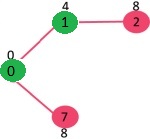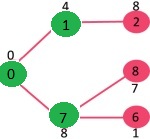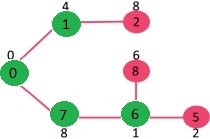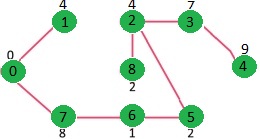概述
Prim算法也是一种贪婪算法,它从一个空的生成树开始,主要思想为维护两个集合:
1.S1 :一个集合包含已经存在于MST(Minimum Spanning Tree)中的节点
2.S2 :一个集合包含没有在MST中的节点
在每一步,它考虑任意一个能够链接两个集合的边,并且从中选择权重最小的边,然后将边的另一个端点加入到S1中。
在图论中,连接两个集合的边被称为割 (cut)
生成树(spanning tree):所有的节点都被连接
算法
1. 创建一个MstSet来维护已经在最小生成树里的点。
2. 给图中所有的点一个初始值,第一个点初始值为0,剩余的点初始值为无穷大,以便于我们从中选择第一个点。
3. (while)只要mstSet还没包含所有的点
a. 从不在mst的点中选择一个有最小值的点u
b. 把u放到mstSet里
c. 更新u的邻接点的值:遍历所有的值,对每一个邻接顶点,如果边u-v的权重比v之前的值要小,更新v的值为u-v的权重
例子
以上图为输入图
mstSet初始为空:{ } 所有顶点的值为{0, INF, INF, INF, INF, INF, INF, INF, INF}
首先我们选择0点作为根节点, 将0放入mstSet并且更新邻接点的值
此时mstSet: { 0 } key: {4, 8, INF, INF, INF, INF, INF, INF}
此时4为最小值,取出1放入mstSet并且更新key
mstSet: {0, 1} key: {8, 8, INF, INF, INF, INF, INF}
此时取出7:
mstSet: {0, 1, 7} key: {1, 7, 8, INF, INF, INF}
取出6:
mstSet: {0, 1, 7, 6} key: {2, 6, 8, INF, INF}
最后得到的树为:
实现
// A C / C++ program for Prim's Minimum Spanning Tree (MST) algorithm. // The program is for adjacency matrix representation of the graph #include <stdio.h> #include <limits.h> // Number of vertices in the graph #define V 5 // A utility function to find the vertex with minimum key value, from // the set of vertices not yet included in MST int minKey(int key[], bool mstSet[]) { // Initialize min value int min = INT_MAX, min_index; for (int v = 0; v < V; v++) if (mstSet[v] == false && key[v] < min) min = key[v], min_index = v; return min_index; } // A utility function to print the constructed MST stored in parent[] int printMST(int parent[], int n, int graph[V][V]) { printf("Edge Weight\n"); for (int i = 1; i < V; i++) printf("%d - %d %d \n", parent[i], i, graph[i][parent[i]]); } // Function to construct and print MST for a graph represented using adjacency // matrix representation void primMST(int graph[V][V]) { int parent[V]; // Array to store constructed MST int key[V]; // Key values used to pick minimum weight edge in cut bool mstSet[V]; // To represent set of vertices not yet included in MST // Initialize all keys as INFINITE for (int i = 0; i < V; i++) key[i] = INT_MAX, mstSet[i] = false; // Always include first 1st vertex in MST. key[0] = 0; // Make key 0 so that this vertex is picked as first vertex parent[0] = -1; // First node is always root of MST // The MST will have V vertices for (int count = 0; count < V-1; count++) { // Pick the minimum key vertex from the set of vertices // not yet included in MST int u = minKey(key, mstSet); // Add the picked vertex to the MST Set mstSet[u] = true; // Update key value and parent index of the adjacent vertices of // the picked vertex. Consider only those vertices which are not yet // included in MST for (int v = 0; v < V; v++) // graph[u][v] is non zero only for adjacent vertices of m // mstSet[v] is false for vertices not yet included in MST // Update the key only if graph[u][v] is smaller than key[v] if (graph[u][v] && mstSet[v] == false && graph[u][v] < key[v]) parent[v] = u, key[v] = graph[u][v]; } // print the constructed MST printMST(parent, V, graph); } // driver program to test above function int main() { /* Let us create the following graph 2 3 (0)--(1)--(2) | / \ | 6| 8/ \5 |7 | / \ | (3)-------(4) 9 */ int graph[V][V] = {{0, 2, 0, 6, 0}, {2, 0, 3, 8, 5}, {0, 3, 0, 0, 7}, {6, 8, 0, 0, 9}, {0, 5, 7, 9, 0}, }; // Print the solution primMST(graph); return 0; }
与Dijsktra的不同
dijsktra中使用从起点到该点的最小距离更新并以此做比较
Prim中使用这条边的权重来更新点的值,并以此做比较





